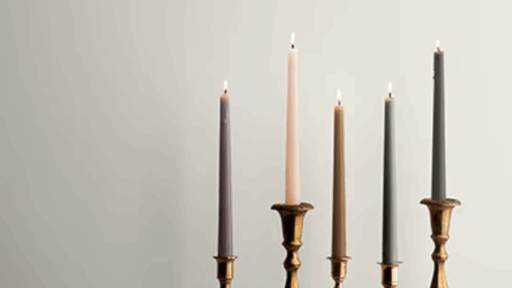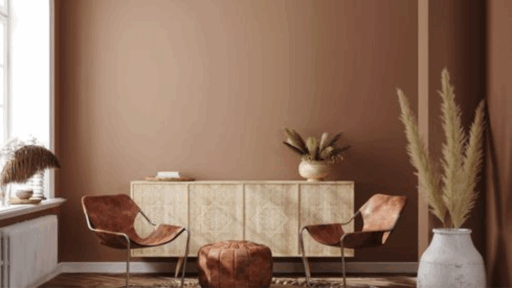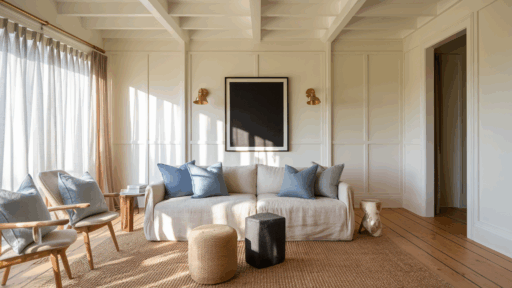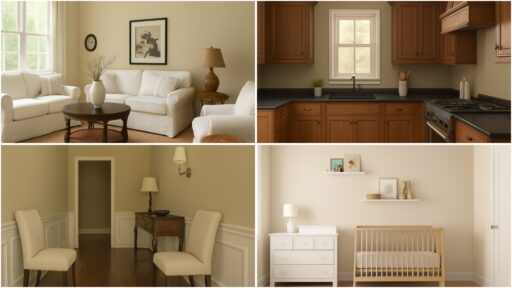If you’ve been searching for a warm off-white that feels soft, welcoming, and stylish, you may be wondering, Is Shoji White the right one for me?
Choosing paint can feel overwhelming. Some colors look too yellow, others too gray, and some vanish in daylight while others feel dull at night.
Shoji White by Sherwin-Williams promises something different. It balances the crispness of white with the cozy softness of beige.
It doesn’t shout, but it doesn’t disappear either. It quietly enhances your room, letting the space, furniture, and natural light do the talking.
Let’s break down exactly why Shoji White might be your next favorite wall color and how it behaves in different rooms, with different tones, and under different lighting.
What Kind of White Is Shoji White by Sherwin-Williams?
Shoji White isn’t your average white paint. It belongs to the off-white family but carries a soft, warm undertone that makes it feel timeless and easy on the eyes.
Sitting in the greige category – a mix of gray and beige – it sometimes leans creamy depending on the lighting. This muted warmth makes Shoji White incredibly versatile.
It works well in both modern minimalist rooms and traditional, cozier spaces.
With a Light Reflectance Value (LRV) of 74, Shoji White reflects a good amount of light without being stark.
It brightens up small rooms and north-facing spaces while keeping things warm and grounded. It won’t feel too harsh in direct sunlight or get lost in shadowy corners.
Its undertones are subtle – a touch of beige and gray that never turns yellow, pink, or peach. Shoji White looks almost white in bright rooms and takes on a soft cream tone in dimmer light.
It pairs beautifully with rich wood, cool or warm accents, and trim in both crisp white or deep contrast shades.
Shoji White in Interior Living Spaces
Shoji White works wonderfully in both living rooms and bedrooms. Its warm softness makes these spaces feel calm and inviting.
Living Room
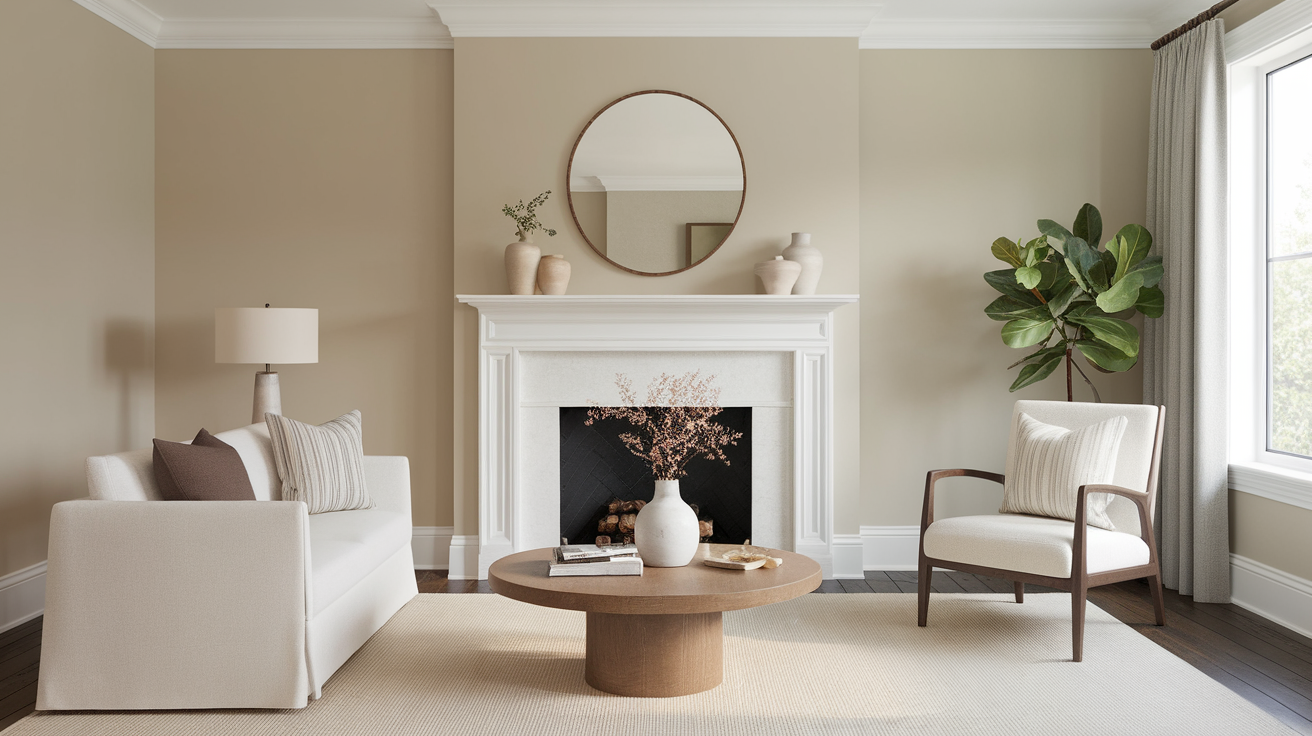
Shoji White is perfect for living rooms that get plenty of natural light. It helps reflect sunlight softly, creating a glow that feels warm but not overpowering.
This shade works especially well with earth-tone furniture, natural wood pieces, or rich leather sofas, giving the space a grounded and timeless vibe.
If your living room features modern touches like black hardware or metal fixtures, Shoji White helps soften those sharp edges and brings balance to the room. It adds warmth to contemporary styles and depth to traditional ones.
Bedroom
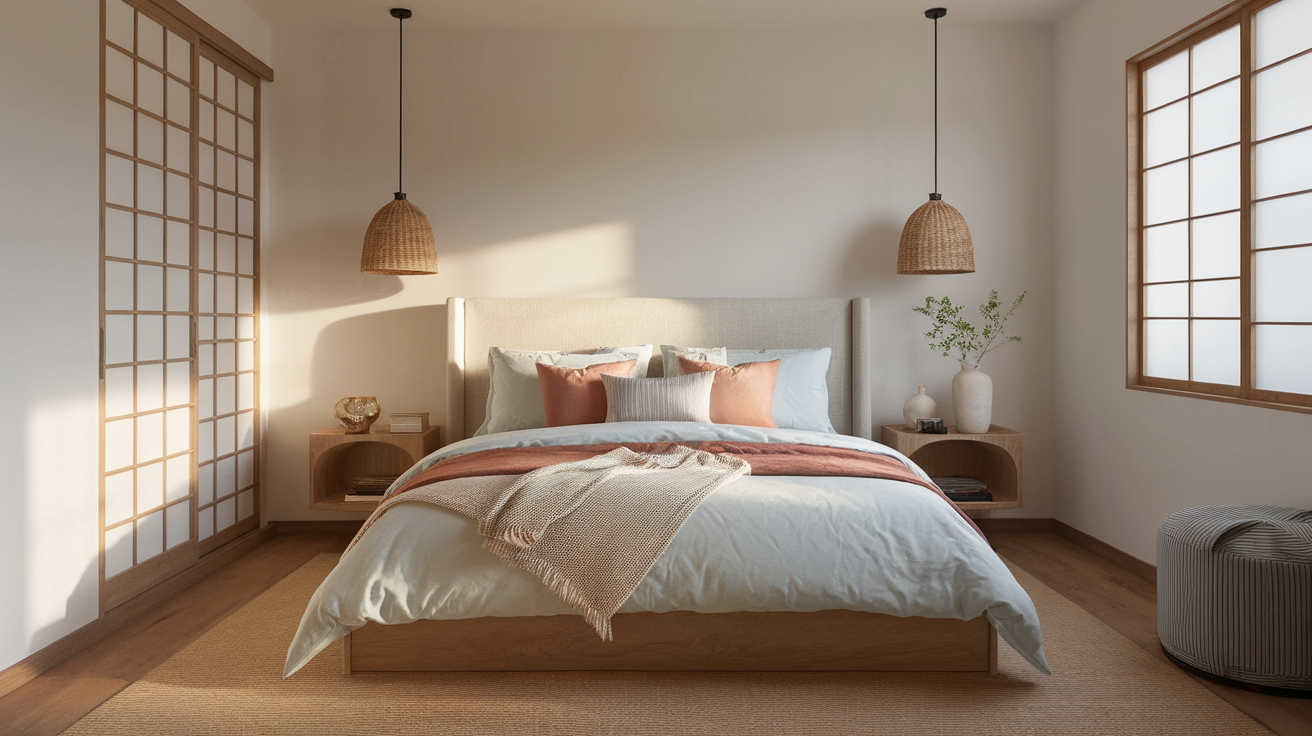
In bedrooms, Shoji White creates a peaceful, spa-like atmosphere that encourages rest.
It pairs beautifully with both warm wood tones and upholstered headboards, making it easy to layer in different styles and materials.
You can style it with bedding in soft blues, oatmeal, or terracotta for a cozy, curated look. It also serves as a perfect backdrop for textured throws, woven baskets, or accent pillows, adding dimension without being loud.
Because of its subtle warmth and neutral tone, it’s a color that works year-round.
Shoji White in Exterior Spaces

Yes, Shoji White works outdoors too. Its warmth looks great on stucco, siding, or brick exteriors, especially in warmer or transitional climates.
For exterior trim, use:
- Pure White for a clean outline
- Iron Ore for dramatic contrast (dark charcoal)
- Natural Choice if you want a soft, seamless look
For ceilings or porch ceilings, Pure White adds clarity and lift, especially in covered areas with shade.
Pair Shoji White with natural materials like stone, cedar wood, or dark roofing to give your home exterior a cozy but modern feel.
Will Shoji White Look Yellow?
One common question is whether Shoji White appears yellow once it’s on the walls. The short answer? No, not if paired correctly.
While it’s a warm white, it doesn’t have strong yellow undertones. That said, under certain lighting conditions (especially very warm, yellow-toned light bulbs), any warm white might seem slightly more yellow.
To keep Shoji White looking clean:
- Use it with neutral or crisp white trim
- Choose bulbs labeled “soft white” or “daylight”
- Balance with cool or earthy accents like soft blues, greens, or grays
Overall, this color stays soft and natural, not buttery or golden.
What Paint Colors Coordinate with Shoji White?
Shoji White is flexible and easy to decorate with. Whether you’re after a calm, neutral space or something with a bit more contrast, the right color pairings can help you set the mood without clashing.
| Color Category | Color Name | Paint Code | Why It Works |
|---|---|---|---|
| Soft & Neutral | Accessible Beige | SW 7036 | Warm and calm, blends seamlessly with Shoji White’s tones |
| Drift of Mist | SW 9166 | A soft off-white that adds subtle contrast | |
| Repose Gray | SW 7015 | Cool and balanced, great for modern neutrals | |
| Bold & Earthy Accents | Urbane Bronze | SW 7048 | Deep, grounding tone that adds richness |
| Pewter Green | SW 6208 | Earthy green that adds natural depth | |
| Cavern Clay | SW 7701 | Warm terracotta that offers a cozy contrast | |
| Dusty Blues/Greens | Sea Salt | SW 6204 | Soft blue-green that feels light and breezy |
| Silvermist | SW 7621 | A cool, muted blue-green for a serene look |
Avoid pairing Shoji White with stark black-and-white color schemes—it’s best in spaces where the goal is softness, natural warmth, and subtle contrast.
Which White Trim Colors Go with Shoji White?
Because Shoji White is an off-white with a warm edge, choosing the right trim color is key.
- Pure White (SW 7005): A clean, soft white that doesn’t overpower
- Alabaster (SW 7008): Slightly warmer, but still distinct from Shoji White
- Extra White (SW 7006): A bright contrast if you want high definition
Each of these provides a different effect. For subtle contrast, use Pure White. If you want to keep things warm and creamy, go with Alabaster.
For a modern contrast, Extra White adds that edge.
How Does Shoji White Compare to Similar Colors?
If you’re deciding between Shoji White and other popular off-whites, it’s helpful to compare:
Shoji White vs. White Duck
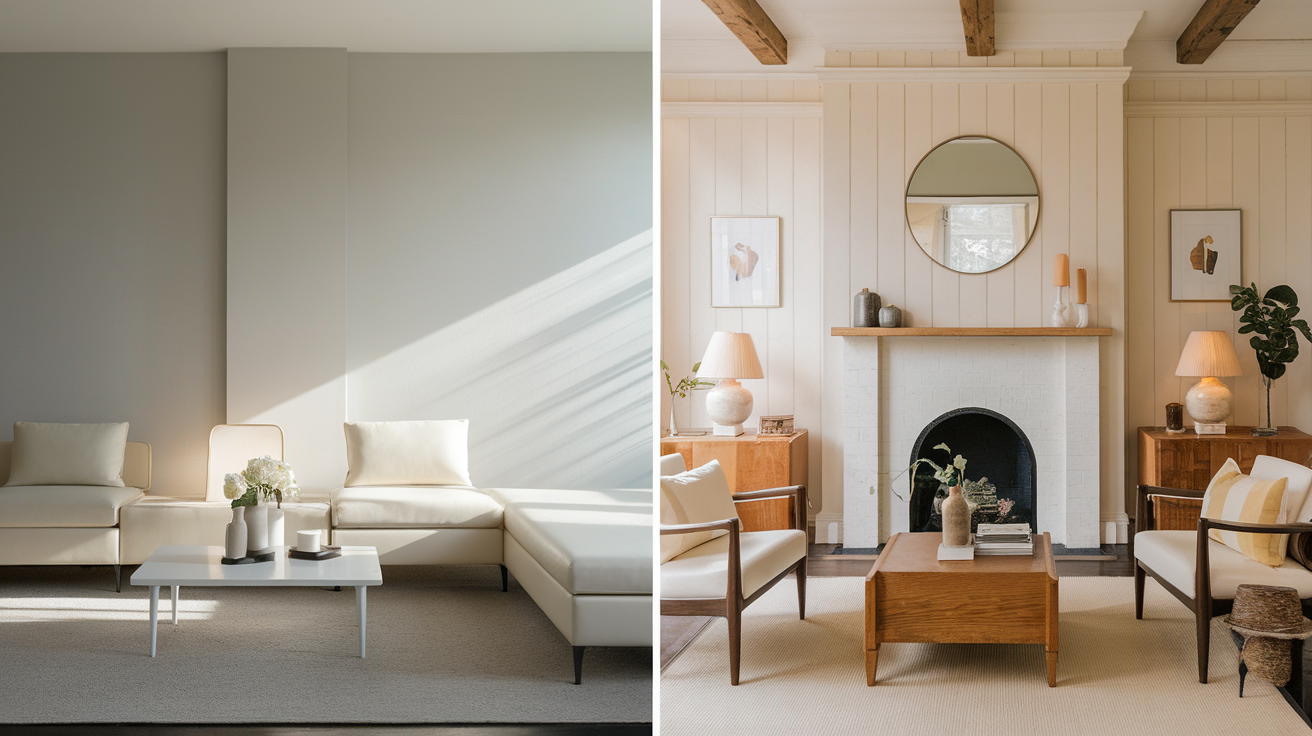
- White Duck is another warm off-white but leans more beige than Shoji White. It feels creamier and can come across as more traditional or heavier.
- Shoji White has a touch more gray, giving it a slightly cooler and crisper look. It often feels airier and more adaptable in modern or transitional spaces.
Shoji White vs. Oyster White and Natural Choice
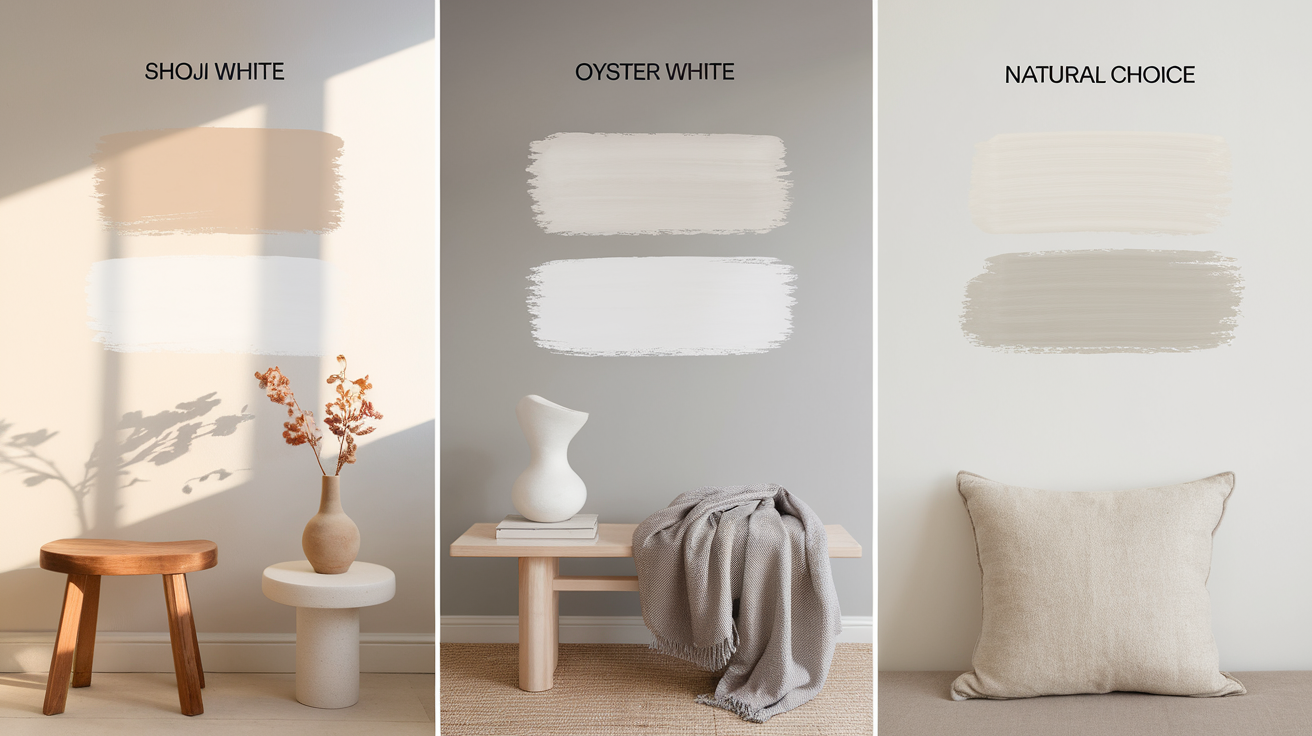
- Oyster White (SW 7637) is cooler and grayer, making it feel more muted in tone.
- Natural Choice (SW 7011) is a bit lighter and more neutral overall.
- Shoji White sits right in the middle—warmer than Oyster White, but deeper than Natural Choice.
If you want warmth without going too dark, Shoji White offers the best balance.
Shoji White vs. Benjamin Moore Wind’s Breath
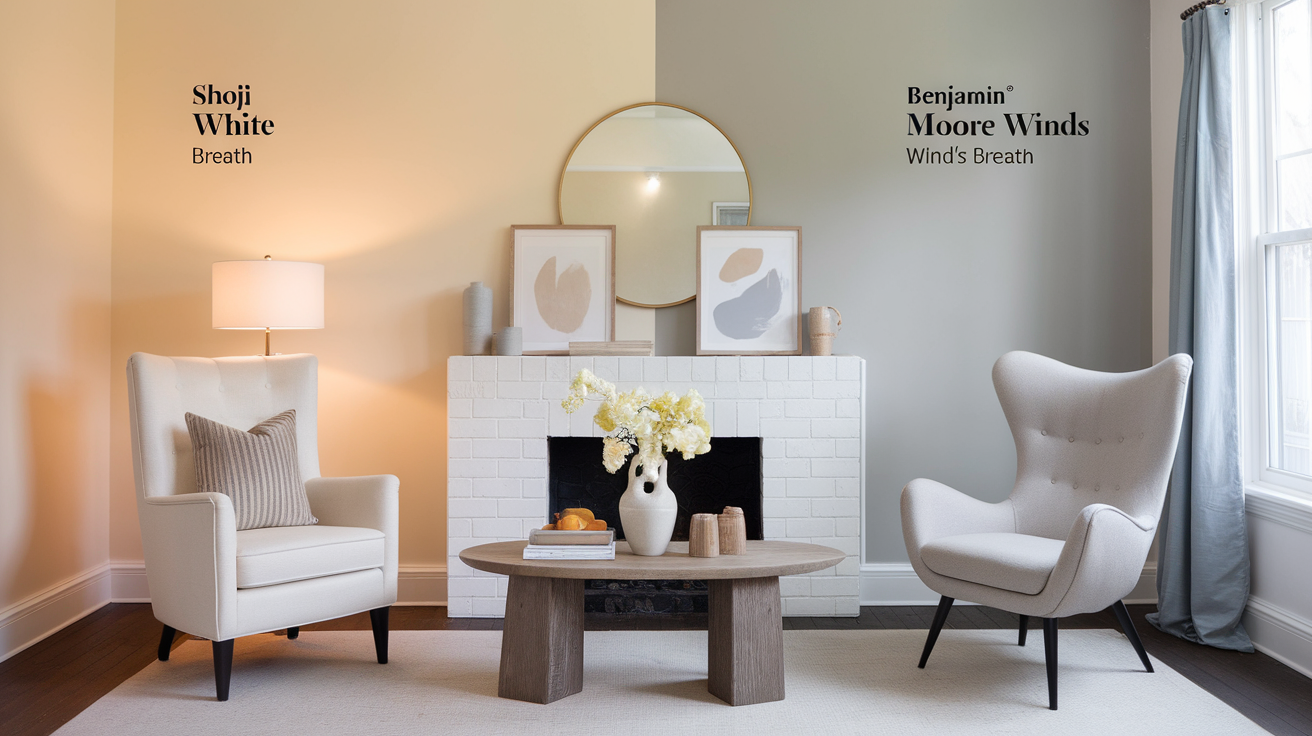
- Wind’s Breath is a close match to Shoji White, with similar beige-gray undertones. It stays a bit more neutral and airy in most spaces.
- Shoji White can appear slightly creamier in warm lighting.
Both work well as soft, warm backdrops and pair beautifully with natural textures.
Final Thoughts
Shoji White by Sherwin-Williams isn’t just another off-white. It’s a versatile, gentle paint color that adapts to many spaces and styles.
It blends easily with warm or cool palettes. It softens the room without feeling yellow.
It holds up under different lighting and brings a calm, cozy feel wherever it’s used.
If you’re painting a space where you want softness, flexibility, and a clean look without harshness, Shoji White may be the answer.
Whether it’s a bedroom, living room, hallway, or even an exterior, this color brings harmony and warmth to your space.
If you’re still unsure, grab a sample. Try it on one wall and live with it for a few days.
Most people find that once they have it up, they don’t want to take it down.





